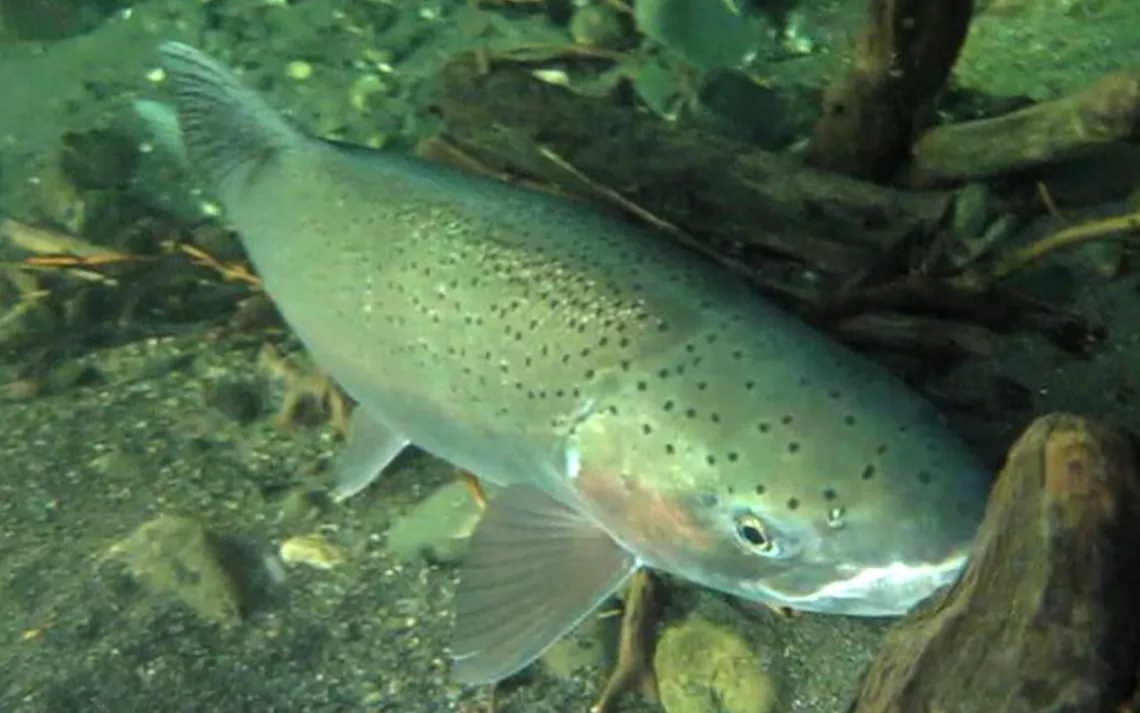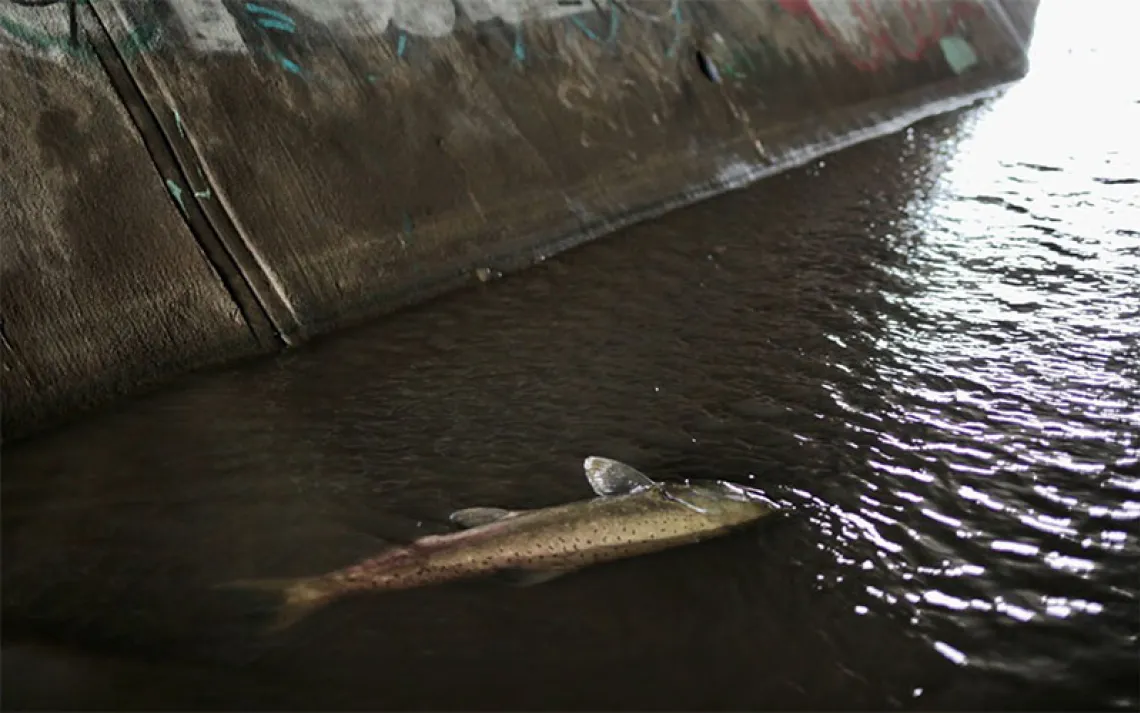Can the Northern California Summer Steelhead Be Saved in Time?
A report lists the status of the fish as “critical”

Eel River steelhead. | Photo by Shawn Thompson/CDFW
Researchers have come to dire conclusions about California’s native fish: Almost half the salmonids are likely to be extinct in the next 50 years, including over half of anadromous species—fish that migrate up freshwater rivers from the ocean to spawn. This is according to the State of the Salmonids II report, which reviewed the status of California’s 32 salmon, trout, and steelhead fish species.
One fish in particular, though, is declining more rapidly: The Northern California summer steelhead trout. In barely a decade, the time since the first SOS report was released, the species had escalated from a high to critical level of concern and its population numbers had plummeted to less than 1,000 adults. While the fish are genetically poised to adapt to warming environments, they could cease to exist by 2050 without intervention and habitat restoration on the Eel River.
In 2018, Friends of the Eel River, a nonprofit in Eureka, filed an official petition to list the summer-run steelhead trout under the California Endangered Species Act (CESA). According to the CA Department of Fish and Wildlife, the CESA process takes a minimum of two years, but there is no legal timeframe by which the entire process must be completed. Recent listings have taken around four years. While the Northern California Summer Steelhead trout were permanently listed in June 2021, conservation experts worry that with added pressures from climate change, endangered species like the Northern California summer steelhead don’t have years to wait for regulation. Now, advocates have taken a crisis management approach to the CESA, putting resources into species that show the most promise in surviving the future.
The Northern California steelhead once claimed a range that spanned from Humboldt County to Mendocino County, but only a few watersheds support summer steelhead now: Redwood Creek and the Mad, Eel, and Mattole Rivers. On the Eel River, they can be found in the mainstem and upper mainstem and the North, Middle, and South Forks. Their journey is long: In the beginning of summer, immature fish enter the river from the Pacific and travel upstream, often resting in deep, cool pools along the way to their estuary. When winter rains come in December to February, they spawn. Mature adults migrate back to sea around March. Juveniles leave their tributaries in the spring, taking time to grow and feed.

Eel River Middle Fork. | Photo by Zane Ruddy/BLM
According to Scott Greacen, the conservation director for Friends of the Eel River, the fish would be more accurately named freshwater salmon. Like their relatives Chinook and coho—which the steelhead trout are more closely related to than sockeye—summer steelhead often migrate back to the same estuaries they were born into to spawn. Getting this trout listed under CESA wasn’t always plausible. Up until recently, winter- and summer-run steelhead were considered genetically similar. The idea that the descendants of the winter run could become summer run led to the belief that winter steelhead would sustain the summer steelhead species if population levels get too low. This was the argument the California Department of Fish and Wildlife made against listing them in previous years.
But summer populations have declined in past years faster than winter run. Fish biologist Samantha Kannry has done yearly population surveys—a three-day hike up and over boulders and through rough terrain—in the Van Duzen, a large tributary off the Eel River, for the past 10 years. She agrees: Population levels are alarmingly low and have been steadily decreasing. This past year, she surveyed a population of around 350 adults in the Middle Fork of the Eel, which is still considered the largest population in the watershed. A healthy population number would be in the thousands per area. “They’ll be gone pretty quickly in our lifetimes,” she said. “Summer steelhead are on the verge of extirpation ... and most people don’t even know they’re here.”
Researchers at UC Davis discovered a specific gene related to run timing—if a fish begins the freshwater journey in the summer, fall, or winter—that suggested summer steelhead are genetically unique. This gene only evolved once in the species’ entire genetic history, meaning the genetic variant that causes the summer run time is unlikely to appear again if lost. The fear that thousands of years of unique genetic history will be gone forever is part of the reason advocates are determined to save this fish.

Make every day an Earth Day
Get articles like this one sent directly to your inbox.
With this action you affirm you want to receive Sierra Club communications and may vote on policy designated by the Sierra Club Board.
The summer-run steelhead trout are the athletes of the salmonids—a class of long, bony cold-water fish that includes salmon, trout, and chars. They swim faster, jump higher, and travel farther—dispersing essential nutrients along the way—than their relatives. They are also incredibly adaptable; they utilize smaller bodies of water that salmon steer clear of and “zoom around,” as Greacen put it, all over the watershed in search of resources during the winter months.

Looking for steelhead in the Eel River Middle Fork. | Photo by Zane Ruddy/BLM

Eel River steelhead close-up. | Photo by Shawn Thompson/CDFW
According to Greacen, one of the co-benefits of getting the summer steelhead listed under CESA could be the removal of two pre-ESA dams on the Eel River. The Scott Dam is currently the end of the line for migrating fish, and that’s only if they managed to make it over the Cape Horn Dam fish ladder at the Lake Van Arsdale reservoir miles before. Both dams are part of the Potter Valley Project, a hydroelectric project that diverts water from the Eel into the Russian River owned by PG&E, the largest utility in California.
The habitat behind Scott Dam is some of the best for summer-run steelhead trout, which prefer bodies of water with large boulders, woody debris, and deep, undercut banks essential for hiding from predators. The California Department of Fish and Wildlife review of the species even acknowledged that Scott Dam blocks about 290 miles of freshwater habitat and states that “removal of Scott Dam provides potential for repopulation of summer steelhead in the upper Eel River basin.” In the Fish and Game Commission’s statement, Scott Dam is cited as a major threat.
In 2019, PG&E decided not to renew the Potter Valley Project’s license with the Federal Energy Regulatory Commission. It also halted attempts to sell it. A coalition of stakeholders developed the Two-Basin Solution—a project that would meet the needs of water users while also restoring habitat for fish—but they were unable to raise the funds needed to buy the license. The Potter Valley Project license remains up in the air, but Greacen believes the summer-run steelhead listing will help expedite a decision to decommission the dams. “We are in a race against time,” he said, saying the dams would ideally be gone within five years. Greacon asserts that a federal ESA listing would also add another level of pressure in the dam-removal argument.
But the time concern remains: Federal ESA listing takes an average of 12 years, and the fight for dam removal is ongoing.
Kannry cited how with some species, there was a clear action needed. For bald eagles, it was banning DDT; for spotted owls, it was limiting timber harvesting. “But with the steelhead, it's just … everything,” she said.
For Caltrout’s Patrick Samuel, it’s deeper than ecological importance and speaks to a sense of societal responsibility. “I think when a species goes extinct, it's a part of our shared human history and culture that goes with it,” he said.
Greacen, who has been in the field for decades, is careful about using the word “hope” when it comes to saving this species through CESA, as it can lead to passiveness. But he does see CESA as a way to bring public awareness and help move along the legal process. “I love the world and I hate what has happened to it,” he said. “What drives me.… It’s not hope. It’s an absolute refusal to let it happen without fighting back.”
 The Magazine of The Sierra Club
The Magazine of The Sierra Club



